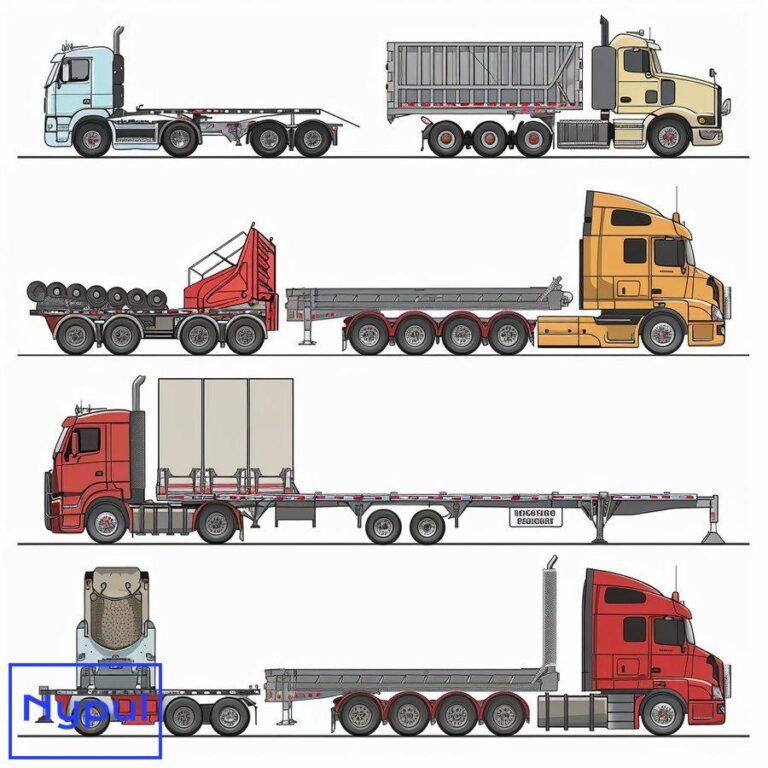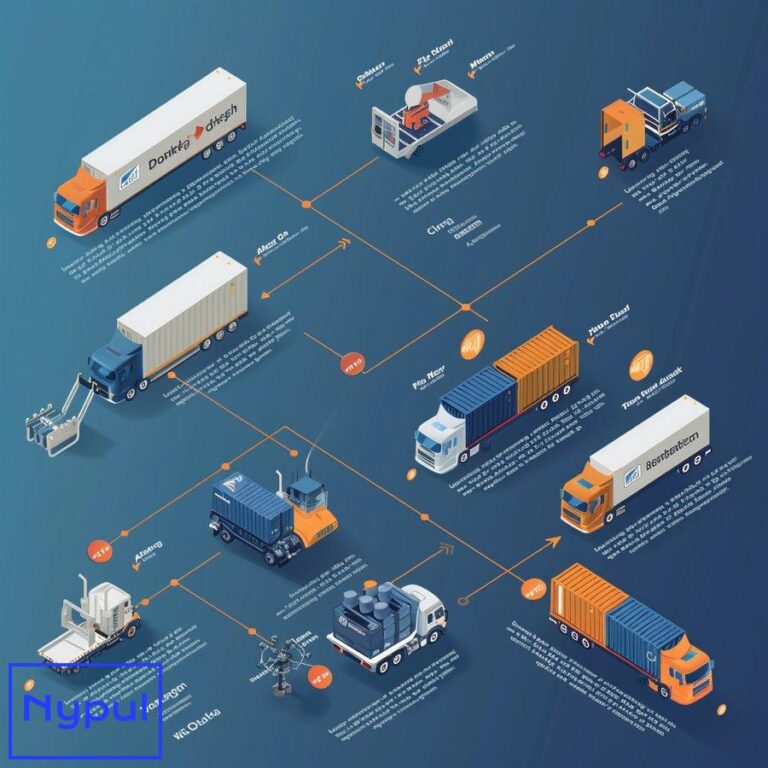How to Reduce Aerodynamic Drag on a Truck
What is aerodynamic drag and why does it matter for trucks?
Aerodynamic drag is the force that opposes a vehicle’s motion through the air. For trucks, this resistance significantly impacts fuel efficiency and operating costs. As a truck moves forward, it must push air out of its way, creating areas of high pressure in front and low pressure behind. This pressure differential results in drag force.
The importance of aerodynamic drag for trucks cannot be overstated. At highway speeds, overcoming air resistance accounts for over 50% of a truck’s total energy expenditure. This translates directly to fuel consumption and emissions. Reducing aerodynamic drag allows trucks to maintain speed with less power, leading to substantial fuel savings over long distances.
Key factors that contribute to a truck’s aerodynamic drag include:
Frontal area: The truck’s face that collides with oncoming air
Shape: How smoothly air flows over the vehicle’s surfaces
Surface roughness: Protrusions that disrupt airflow
Gap between tractor and trailer: Creates turbulence
Underbody airflow: Rough undercarriage increases drag
For fleet managers and owner-operators, understanding aerodynamic drag is crucial for optimizing vehicle performance and reducing operating costs. Even small improvements in aerodynamics can yield significant fuel savings when multiplied across a fleet and thousands of miles.
To illustrate the impact of speed on aerodynamic drag, consider this table showing the relationship between velocity and drag force:
| Speed (mph) | Relative Drag Force |
|---|---|
| 30 | 1.0 |
| 45 | 2.25 |
| 60 | 4.0 |
| 75 | 6.25 |
As speed increases, drag force grows exponentially. This highlights why aerodynamic efficiency becomes increasingly important at highway speeds.
Reducing aerodynamic drag offers several benefits for trucking operations:
Fuel savings: Lower drag means less fuel burned to maintain speed
Increased range: Improved efficiency allows trucks to travel further on a single tank
Reduced emissions: Less fuel consumption results in lower greenhouse gas output
Improved stability: Proper aerodynamics can enhance vehicle handling, especially in crosswinds
Extended component life: Reduced stress on the engine and drivetrain can improve longevity
For the trucking industry, addressing aerodynamic drag is not just about immediate cost savings. It’s an essential step towards more sustainable and efficient freight transportation. As regulations tighten and fuel prices fluctuate, optimizing aerodynamics becomes a competitive advantage.
In the following sections, we’ll explore various strategies and technologies to reduce aerodynamic drag on trucks, from tractor modifications to operational best practices. Each approach offers unique benefits and considerations for fleet managers looking to enhance their vehicles’ performance on the road.
How do tractor modifications reduce drag on a truck?
Tractor modifications play a crucial role in reducing aerodynamic drag on trucks. These alterations focus on reshaping the tractor to allow air to flow more smoothly around the vehicle, minimizing turbulence and resistance. Let’s explore the key areas where tractor modifications can make a significant impact.
Front-end design

The front of the tractor is the first point of contact with oncoming air. Optimizing this area can dramatically reduce drag:
Sloped hood: A gently sloping hood helps guide air over the top of the truck rather than creating a flat surface for air to collide with. This modification can reduce drag by up to 5%.
Rounded corners: Sharp edges create turbulence. Rounding the corners of the cab and hood allows air to flow more smoothly around the vehicle.
Integrated bumper: Merging the bumper with the overall design of the front end reduces protrusions that can disrupt airflow.
Aerodynamic mirrors: Replacing traditional box-shaped mirrors with sleek, aerodynamic designs can reduce drag by 1-2%.
Cab fairings
Fairings are add-on components that improve the tractor’s aerodynamic profile:
Roof fairing: This curved extension on top of the cab directs air over the trailer, reducing the drag-inducing gap between tractor and trailer. Roof fairings can improve fuel efficiency by 7-10%.
Side fairings: These panels smooth the transition from the cab to the trailer, reducing turbulence along the sides of the vehicle.
Cab extenders: These fill the gap between the back of the cab and the trailer, preventing air from becoming trapped and creating drag.
Wheel covers
Exposed wheels create significant turbulence. Covering the wheels can reduce this effect:
Full wheel covers: These smooth covers over the entire wheel can reduce drag by up to 1%.
Wheel fairings: Partial covers that direct air around the wheels can offer similar benefits with less weight.
Air dams
An air dam is a panel mounted under the front bumper that reduces airflow under the truck:
Front air dam: This component can reduce drag by up to 2% by preventing air from flowing under the vehicle and creating turbulence.
Side skirts: While primarily a trailer modification, some tractors incorporate side skirts to further reduce underbody airflow.
Advanced technologies
Some cutting-edge modifications push the boundaries of aerodynamic design:
Active grille shutters: These automatically close off the grille at highway speeds to reduce drag, opening only when engine cooling is needed.
Retractable side steps: Steps that fold away when not in use eliminate unnecessary protrusions.
Camera systems: Replacing mirrors with cameras can significantly reduce drag while improving visibility.
To illustrate the potential impact of these modifications, consider this table showing approximate fuel savings for various tractor improvements:
| Modification | Potential Fuel Savings |
|---|---|
| Roof fairing | 7-10% |
| Side fairings | 2-4% |
| Aerodynamic mirrors | 1-2% |
| Wheel covers | 0.5-1% |
| Front air dam | 1-2% |
| Sloped hood design | 3-5% |
It’s important to note that these savings can be cumulative when multiple modifications are implemented together.
For fleet managers and owner-operators, the decision to invest in tractor modifications should be based on a careful cost-benefit analysis. While some modifications can be expensive upfront, the long-term fuel savings often justify the investment, especially for trucks that cover long distances at highway speeds.
When considering tractor modifications, keep in mind:
Compatibility: Ensure modifications work with your specific tractor model and intended trailer types.
Maintenance: Some add-on components may require additional maintenance or be prone to damage.
Weight: While aerodynamic improvements save fuel, added weight from modifications can partially offset these gains.
Regulations: Ensure all modifications comply with local and national regulations regarding vehicle dimensions and safety standards.
By carefully selecting and implementing tractor modifications, trucking operations can significantly reduce aerodynamic drag, leading to improved fuel efficiency, lower operating costs, and a reduced environmental impact. As aerodynamic technology continues to advance, staying informed about the latest developments can help fleets maintain a competitive edge in the industry.
Which trailer enhancements can improve aerodynamics?

Trailer enhancements play a crucial role in reducing overall truck aerodynamic drag. While the tractor leads the way, the trailer accounts for a significant portion of the vehicle’s aerodynamic profile. Implementing trailer improvements can lead to substantial fuel savings and increased efficiency. Let’s explore the key trailer enhancements that can make a significant impact on aerodynamics.
Side skirts
Side skirts are panels that extend from the trailer’s sides to the ground, reducing airflow underneath the trailer:
Full-length skirts: These cover the entire length of the trailer and can reduce fuel consumption by 4-7%.
Partial skirts: Covering only the rear portion of the trailer, these offer some benefits with less material and weight.
Flexible skirts: Made from durable but flexible materials, these are less prone to damage from road debris or docking impacts.
Rear devices
The back of the trailer is a major source of aerodynamic drag due to the sudden air separation it causes:
Boat tails: These extensions taper the rear of the trailer, reducing the low-pressure wake behind the vehicle. Boat tails can improve fuel efficiency by 3-5%.
Vortex generators: Small fins or tabs on the trailer’s rear edges help guide airflow and reduce turbulence.
Inflatable tails: These systems deploy at highway speeds and deflate for easier docking.
Gap reducers
The gap between the tractor and trailer creates significant turbulence:
Gap fairings: These panels extend from the front of the trailer to reduce the tractor-trailer gap.
Nose cones: Placed on the front of the trailer, these streamlined shapes help guide air around the gap.
Top devices
Modifications to the trailer’s roof can help manage airflow:
Roof fairings: These curved panels on the trailer’s front upper edge help direct air over the top of the trailer.
Vortex generators: Placed along the trailer’s roof, these small devices can help reduce drag-inducing separation of airflow.
Underbody improvements
Smoothing the trailer’s underside can significantly reduce drag:
Aerodynamic mud flaps: These designs allow more air to pass through, reducing turbulence.
Smooth underbody panels: Covering exposed cross-members and other components reduces drag-inducing roughness.
To illustrate the potential impact of these enhancements, consider this table showing approximate fuel savings for various trailer improvements:
| Enhancement | Potential Fuel Savings |
|---|---|
| Side skirts | 4-7% |
| Boat tails | 3-5% |
| Gap reducers | 1-2% |
| Roof fairings | 1-2% |
| Underbody panels | 1-2% |
When implementing trailer enhancements, fleet managers and owner-operators should consider:
Operational compatibility: Ensure modifications don’t interfere with loading, unloading, or intermodal operations.
Durability: Trailer enhancements must withstand harsh road conditions and frequent coupling/uncoupling.
Weight considerations: While aerodynamic improvements save fuel, added weight can partially offset these gains.
Maintenance requirements: Some devices may require regular inspection and maintenance to ensure optimal performance.
Regulatory compliance: Ensure all modifications meet local and national regulations for vehicle dimensions and safety.
Retrofit vs. new purchase: Consider whether to retrofit existing trailers or invest in new, aerodynamically optimized models.
For fleets with diverse operations, it’s essential to match aerodynamic enhancements to specific use cases:
Long-haul operations: Benefit most from comprehensive aerodynamic packages, including side skirts, boat tails, and gap reducers.
Regional haul: May focus on lighter, more durable options like partial skirts and vortex generators.
Urban delivery: Might prioritize flexible, damage-resistant enhancements that don’t impede frequent stops and tight maneuvers.
Implementing trailer enhancements requires careful planning and consideration of the specific needs of your operation. However, the potential for significant fuel savings and reduced emissions makes these improvements a worthwhile investment for many trucking companies.
As aerodynamic technology continues to evolve, staying informed about the latest developments in trailer enhancements can help fleets maintain a competitive edge. By combining tractor modifications with optimized trailer designs, trucking operations can achieve substantial improvements in overall aerodynamic efficiency, leading to reduced operating costs and a smaller environmental footprint.
What underbody improvements minimize air resistance?
Underbody improvements play a crucial role in minimizing air resistance for trucks. The area beneath a truck and trailer is often overlooked, but it can significantly contribute to overall aerodynamic drag. By implementing strategic underbody enhancements, fleet managers and owner-operators can achieve notable improvements in fuel efficiency and vehicle performance.

Smooth underbody panels
Installing smooth panels beneath the truck and trailer creates a more aerodynamic surface:
Full-length panels: These cover the entire underside of the vehicle, providing maximum drag reduction.
Partial panels: Strategic placement in high-turbulence areas can offer significant benefits with less added weight.
Material considerations: Lightweight, durable materials like reinforced plastics or composites minimize the weight penalty.
Aerodynamic mud flaps
Traditional mud flaps can create significant drag. Aerodynamic alternatives offer protection while reducing air resistance:
Vented designs: Allow air to pass through, reducing turbulence behind the flaps.
Flexible materials: Move with airflow, further reducing drag compared to rigid flaps.
Integrated systems: Combine underbody panels with aerodynamic mud flaps for comprehensive drag reduction.
Wheel well enhancements
The open spaces around wheels create turbulence and drag:
Wheel well covers: Partially or fully enclose the wheel wells to smooth airflow.
Aerodynamic mudguards: Shaped to guide air around the wheels more efficiently.
Fender skirts: Extended fenders that reduce air circulation in the wheel well area.
Crossmember fairings
Exposed crossmembers beneath the trailer create drag-inducing roughness:
Individual fairings: Cover each crossmember with an aerodynamic shape.
Continuous fairings: A single, smooth panel covering multiple crossmembers.
Tapered designs: Shape fairings to guide air smoothly along the vehicle’s length.
Fuel tank fairings
Exposed fuel tanks disrupt underbody airflow:
Streamlined covers: Encase fuel tanks in aerodynamic shells.
Integrated designs: Incorporate fuel tank fairings into overall underbody paneling.
Air management systems
Active systems can further optimize underbody airflow:
Adjustable air dams: Lower at highway speeds to reduce underbody air entry.
Controllable vents: Manage airflow for cooling or aerodynamics as needed.
To illustrate the potential impact of these improvements, consider this table showing approximate fuel savings for various underbody enhancements:
| Enhancement | Potential Fuel Savings |
|---|---|
| Full underbody panels | 2-4% |
| Aerodynamic mud flaps | 0.5-1% |
| Wheel well covers | 0.5-1% |
| Crossmember fairings | 0.5-1% |
| Fuel tank fairings | 0.3-0.5% |
| Air management systems | 1-2% |
When implementing underbody improvements, consider the following factors:
Ground clearance: Ensure modifications don’t reduce ground clearance below safe or regulatory limits.
Access for maintenance: Design improvements to allow easy access to critical components.
Durability: Underbody enhancements must withstand road debris, weather, and potential impacts.
Weight considerations: Balance aerodynamic gains against any added weight from improvements.
Compatibility: Ensure modifications work with various trailer types and configurations in your fleet.
Cost-effectiveness: Evaluate the return on investment based on your specific operational profile.
For different trucking operations, prioritize underbody improvements based on specific needs:
Long-haul operations: Benefit most from comprehensive underbody paneling and air management systems.
Regional haul: May focus on partial paneling and aerodynamic mud flaps for a balance of efficiency and flexibility.
Vocational trucks: Might prioritize durable, impact-resistant improvements that don’t interfere with specialized equipment.
Implementing underbody improvements requires careful planning and consideration of your fleet’s specific requirements. However, the potential for significant fuel savings and reduced emissions makes these enhancements a valuable investment for many trucking operations.
As technology advances, new materials and designs continue to improve the effectiveness of underbody aerodynamics. Staying informed about these developments can help fleet managers make informed decisions about implementing the most effective underbody improvements for their vehicles.
By combining underbody enhancements with other aerodynamic modifications to the tractor and trailer, trucking companies can achieve substantial reductions in overall aerodynamic drag. This comprehensive approach leads to improved fuel efficiency, lower operating costs, and a reduced environmental impact – all crucial factors in today’s competitive and environmentally conscious trucking industry.
How do active aerodynamic systems work on trucks?
Active aerodynamic systems represent a cutting-edge approach to reducing drag on trucks. Unlike static aerodynamic enhancements, these systems can adapt to changing conditions, optimizing airflow in real-time. This dynamic capability allows for maximum efficiency across various driving scenarios, from highway cruising to urban maneuvering.
Adjustable air dams
These systems modify the truck’s frontal profile based on speed and conditions:
Speed-sensitive deployment: Lowers the air dam at highway speeds to reduce underbody airflow.
Obstacle detection: Raises the air dam when approaching steep inclines or obstacles.
Integration with vehicle systems: Uses data from the truck’s speed sensors and GPS to optimize positioning.
Active grille shutters
These systems manage airflow through the engine compartment:Active grille shutters
These systems manage airflow through the engine compartment:
Dynamic operation: Grille shutters automatically open and close based on engine temperature and speed, optimizing cooling while minimizing drag.
Fuel efficiency benefits: By reducing the amount of air entering the engine compartment at high speeds, active grille shutters can improve fuel efficiency by 1-2%.
Integration with other systems: These shutters can work in conjunction with other active aerodynamic features to create a cohesive aerodynamic strategy.
Retractable side skirts
These innovative designs enhance aerodynamics without sacrificing functionality:
Deployment based on speed: Side skirts can extend at highway speeds to reduce airflow underneath the trailer and retract when maneuvering in tight spaces.
Durability considerations: Made from flexible materials, these skirts can withstand impacts while maintaining their aerodynamic properties.
Improved stability: By reducing turbulence, retractable side skirts can enhance vehicle stability, especially in crosswinds.
Vortex generators
These small devices can be strategically placed on various truck surfaces to manipulate airflow:
Placement optimization: Vortex generators create controlled turbulence that helps maintain attached airflow over surfaces, reducing drag.
Versatility: They can be applied to trailers, cab roofs, and even wheel wells to improve overall aerodynamic performance.
Cost-effective solution: Vortex generators are relatively inexpensive compared to other aerodynamic modifications and can provide noticeable improvements in fuel efficiency.
To illustrate the impact of active aerodynamic systems, consider this table showing approximate fuel savings for various technologies:
| Active System | Potential Fuel Savings |
|---|---|
| Adjustable air dams | 1-2% |
| Active grille shutters | 1-2% |
| Retractable side skirts | 3-5% |
| Vortex generators | 0.5-1% |
When implementing active aerodynamic systems, fleet managers should consider:
Initial costs: While these systems may require a higher upfront investment, the potential fuel savings can justify the expense over time.
Maintenance requirements: Active systems may need regular checks and maintenance to ensure proper operation.
Compatibility with existing vehicles: Ensure that active systems are compatible with your fleet’s current models or consider retrofitting options.
Driver training: Educate drivers on how these systems work and their benefits to maximize their effectiveness.
Active aerodynamic systems represent a significant advancement in truck design and efficiency. By dynamically adjusting to driving conditions, these technologies can greatly reduce drag and improve fuel economy. As the trucking industry continues to evolve towards sustainability and efficiency, investing in active aerodynamic solutions will be crucial for fleets aiming to stay competitive.
What operational strategies can drivers use to reduce drag?
While vehicle modifications play a significant role in reducing aerodynamic drag, drivers also have a critical part to play. Implementing effective operational strategies can further enhance fuel efficiency and minimize drag during day-to-day operations. Here are several key strategies that drivers can adopt:
Speed management
Driving at optimal speeds is essential for minimizing drag:
Maintain steady speeds: Rapid acceleration and deceleration increase aerodynamic drag. Using cruise control on highways helps maintain a consistent speed.
Optimal speed range: Most trucks achieve the best fuel economy between 55-65 mph. Operating within this range minimizes drag while maximizing fuel efficiency.
Avoid unnecessary idling: Idling increases fuel consumption without providing any forward motion. Drivers should turn off engines during long stops.
Smooth driving techniques
Adopting smooth driving habits reduces drag and improves fuel efficiency:
Gentle acceleration and braking: Gradual changes in speed help maintain momentum and reduce turbulence around the vehicle.
Anticipate traffic flow: Observing traffic patterns allows drivers to adjust their speed proactively rather than reactively, reducing abrupt movements.
Minimize lane changes: Frequent lane changes increase drag due to turbulence; maintaining a steady lane position is more efficient.
Proper loading techniques
How a truck is loaded affects its aerodynamics:
Weight distribution: Ensure even weight distribution across the trailer to maintain stability and minimize drag from uneven airflow.
Secure cargo: Properly securing cargo prevents shifting during transit, which could alter the truck’s profile and increase drag.
Aerodynamic trailer configurations: Use trailers designed for optimal aerodynamics when possible, such as those with integrated side skirts or boat tails.
Route planning
Planning routes effectively can help reduce overall travel time and improve fuel efficiency:
Avoid congested areas: Traffic jams lead to frequent stopping and starting, increasing drag. Use navigation tools that provide real-time traffic updates.
Choose flatter routes when possible: Steeper inclines require more power from the engine, increasing fuel consumption. Opt for routes with less elevation change if feasible.
To illustrate how operational strategies impact fuel savings, consider this table showing approximate savings based on driver behavior:
| Strategy | Potential Fuel Savings |
|---|---|
| Speed management | 5-10% |
| Smooth driving techniques | 3-5% |
| Proper loading techniques | 2-4% |
| Route planning | 2-6% |
When implementing these operational strategies, drivers should consider:
Training programs: Regular training sessions on efficient driving techniques can foster better habits among drivers.
Performance monitoring: Use telematics systems to track driver behavior and identify areas for improvement in fuel efficiency.
Feedback loops: Encourage open communication between drivers and management regarding challenges faced while implementing these strategies.
By adopting effective operational strategies alongside vehicle modifications, trucking companies can achieve substantial reductions in aerodynamic drag. This holistic approach leads not only to improved fuel efficiency but also contributes positively to overall operational costs and environmental impact.
How is aerodynamic efficiency measured and tested?
Measuring and testing aerodynamic efficiency is crucial for understanding how well a truck performs under various conditions. Accurate assessments allow fleet managers and manufacturers to identify areas for improvement and validate the effectiveness of modifications. Here are key methods used for measuring aerodynamic efficiency in trucks:
Wind tunnel testing
Wind tunnel testing is one of the most reliable methods for evaluating a vehicle’s aerodynamics:
Controlled environment: Trucks are placed in a wind tunnel where airflow conditions can be precisely controlled and measured.
Data collection: Sensors measure forces acting on the vehicle, including drag force, lift force, and pressure distribution across surfaces.
Visualization techniques: Smoke or laser light can visualize airflow patterns around the truck, helping engineers identify areas of turbulence or separation.
Wind tunnel testing provides valuable insights into how design changes affect aerodynamics before implementation on real-world vehicles. However, it requires significant investment in facilities and equipment.
Computational fluid dynamics (CFD)
CFD simulations use computer algorithms to model airflow around vehicles:
Cost-effective alternative: CFD allows engineers to test multiple design iterations without physical prototypes, saving time and resources.
Detailed analysis: Simulations provide comprehensive data on pressure distribution, flow velocity, and turbulence levels across various surfaces of the truck.
CFD is increasingly popular among manufacturers due to its flexibility and ability to predict real-world performance accurately.
On-road testing
Real-world testing complements wind tunnel results by evaluating performance under actual driving conditions:
Fuel consumption measurements: Monitoring fuel usage over specific routes helps quantify improvements in aerodynamic efficiency from modifications or new technologies.
Telematics data collection: Advanced telematics systems provide insights into speed profiles, acceleration patterns, and overall vehicle performance during normal operations.
On-road testing validates theoretical predictions from wind tunnel tests or CFD simulations by providing tangible results under varying conditions such as weather changes or load variations.
To summarize methods of measuring aerodynamic efficiency, consider this table outlining each method’s advantages:
| Method | Advantages |
|---|---|
| Wind tunnel testing | Controlled environment; precise data |
| Computational fluid dynamics (CFD) | Cost-effective; detailed analysis |
| On-road testing | Real-world validation; practical insights |
When measuring aerodynamic efficiency, it’s essential for fleet managers to consider:
Budget constraints: Each method has different costs associated with setup or execution; choose based on available resources.
Time requirements: Wind tunnel tests may take longer than CFD simulations but provide more accurate results; balance time against accuracy needs.
By employing a combination of these measurement techniques—wind tunnel testing for controlled assessments, CFD for cost-effective simulations, and on-road tests for real-world validation—trucking companies can gain comprehensive insights into their vehicles’ aerodynamic performance. This knowledge enables informed decisions about modifications that lead directly to improved fuel efficiency and reduced operating costs over time.
What is the cost-benefit analysis of implementing drag reduction measures?

Implementing drag reduction measures requires careful consideration of costs versus benefits. A thorough cost-benefit analysis helps fleet managers evaluate whether investing in aerodynamic enhancements will yield worthwhile returns. Here’s how to approach this analysis effectively:
Initial Costs
The upfront costs associated with implementing drag reduction measures vary widely depending on the type of modifications chosen:
- Tractor modifications:
- Fairings: $1,000 – $3,000
- Aerodynamic mirrors: $200 – $500
-
Sloped hoods: $3,000 – $7,000
-
Trailer enhancements:
- Side skirts: $1,500 – $3,500
- Boat tails: $2,000 – $4,000
-
Roof fairings: $1,000 – $2,500
-
Underbody improvements:
- Full underbody panels: $2,000 – $5,000
-
Aerodynamic mud flaps: $100 – $300
-
Active systems:
- Adjustable air dams: $1,500 – $3,000
- Active grille shutters: $500 – $1,500
Operational Costs
In addition to initial investments in equipment or modifications:
-
Maintenance expenses: Regular maintenance may be required for certain enhancements (e.g., active systems), adding ongoing costs.
-
Training programs: Educating drivers about new technologies or techniques incurs additional expenses but enhances overall effectiveness.
Potential Savings
The potential savings from implementing drag reduction measures are substantial when calculated over time:
- Fuel savings per year per truck:
-
Tractor modifications: Average savings of $1,200 – $2,500 annually.
-
Trailer enhancements: Average savings of $800 – $1,800 annually.
-
Underbody improvements: Average savings of $600 – $1,200 annually.
-
Total annual savings per truck (with combined measures):
$$\text{Total Savings} = \text{Tractor Savings} + \text{Trailer Savings} + \text{Underbody Savings}$$
For example:
$$\text{Total Savings} = \$1{,}800 + \$1{,}200 + \$900 = \$3{,}900$$
Return on Investment (ROI)
Calculating ROI provides insight into whether investments will pay off over time:
$$\text{ROI} = \frac{\text{Total Savings} – \text{Initial Costs}}{\text{Initial Costs}} \times 100$$
For instance:
If initial costs total \$5{,}000:
$$\text{ROI} = \frac{\$3{,}900 – \$5{,}000}{\$5{,}000} \times 100 = -22\%$$
This indicates a negative ROI initially but could turn positive if long-term savings accumulate over several years as initial costs are recouped through reduced fuel expenses.
Long-Term Considerations
Beyond immediate financial metrics like ROI or payback periods:
-
Environmental impact: Reduced emissions contribute positively towards sustainability goals.
-
Regulatory compliance: Meeting future emissions standards may necessitate investing in more efficient vehicles sooner rather than later.
-
Market competitiveness: Enhanced fuel economy improves overall competitiveness within an industry increasingly focused on sustainability practices.
By conducting thorough cost-benefit analyses before implementing drag reduction measures—factoring both tangible financial metrics alongside broader considerations—trucking companies can make informed decisions that align with their operational goals while maximizing returns over time.
In conclusion—reducing aerodynamic drag through targeted modifications not only enhances vehicle performance but also leads directly towards substantial cost savings over extended periods—a win-win scenario for both operators striving towards profitability as well as environmental stewardship within an evolving industry landscape.






